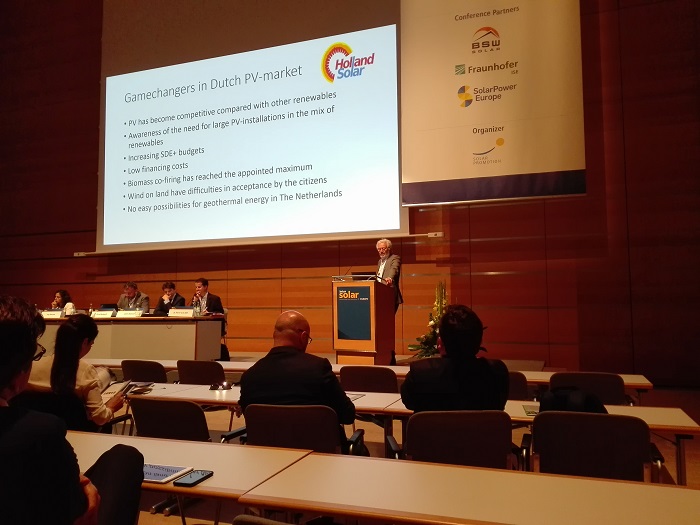Solar’s time to shine in the Netherlands is now, said Holland Solar president Jaap Baarsma on day one of the Intersolar Europe Conference in Munich.
According to Baarsma, the Netherlands will soon add more than 1 GW of solar annually, if not this year then at least by 2018, he said. Currently, the Netherlands has just over 2 GW of cumulative solar capacity installed.
This thirst for solar power is largely being driven by increased cost-competitiveness for PV and a supportive policy in the SDE+ tender, which is energy-agnostic (excluding offshore wind) and increasingly finding favor among solar developers.
Historically, the SDE tender has delivered surging growth to the Dutch biomass sector, but in 2017 biomass has now reached its maximum co-firing allocation, Baarsma told the audience, thus clearing the way for solar PV to swoop in.
“Solar is becoming much more competitive in terms of cost against other energy sources,” Baarsma explained. “And with the SDE budgets increasing, solar applications in the first half of the year reached 2.6 GW, with similar amounts of interest expected in the second half of 2017.”
Holland Solar is confident that all of this +5 GW of potential solar capacity will be approved due to the strong SDE budget available right now. Growth will arrive across all segments – residential rooftop, commercial rooftop, and utility scale – Baarsma said, given that the SDE is supportive of all forms of solar installations.
Aesthetics plays a big part in the Dutch residential solar market, stressed Wilma Eerenstein, R&D manager of Netherlands-based Exasun, at a later session.
“The PV price is currently between 9-18 U.S. cents/kWh in the Netherlands, which makes solar still quite expensive for large-scale but attractive for residential consumers,” said Eerenstein. “So lowering LCOE is paramount, and to do that the market has to ensure that solar modules in the Netherlands have higher efficiency, longer lifetimes, are aesthetically pleasing and can be installed into as many different types of buildings as possible.”
Earlier today, SolarPower Europe CEO James Watson said that the Netherlands, along with Turkey, is one of the nations most likely to step into the solar space vacated by the U.K. this year.
This content is protected by copyright and may not be reused. If you want to cooperate with us and would like to reuse some of our content, please contact: editors@pv-magazine.com.



By submitting this form you agree to pv magazine using your data for the purposes of publishing your comment.
Your personal data will only be disclosed or otherwise transmitted to third parties for the purposes of spam filtering or if this is necessary for technical maintenance of the website. Any other transfer to third parties will not take place unless this is justified on the basis of applicable data protection regulations or if pv magazine is legally obliged to do so.
You may revoke this consent at any time with effect for the future, in which case your personal data will be deleted immediately. Otherwise, your data will be deleted if pv magazine has processed your request or the purpose of data storage is fulfilled.
Further information on data privacy can be found in our Data Protection Policy.